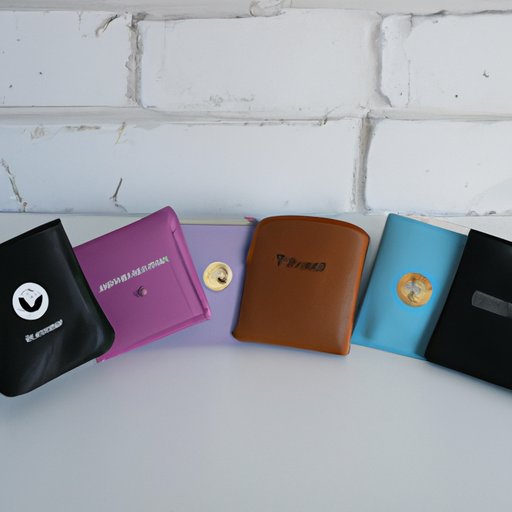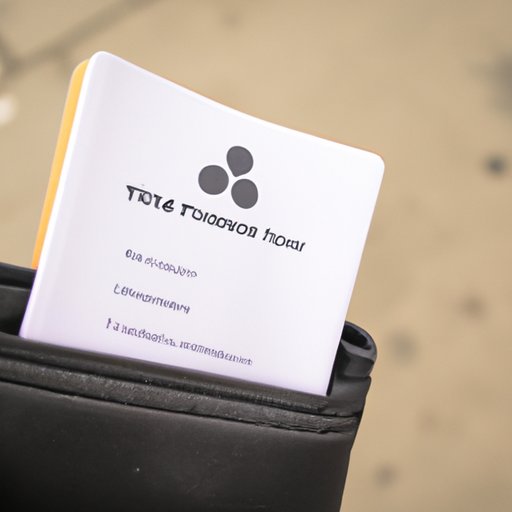Introduction
A cryptocurrency wallet is an essential tool for anyone looking to store, send or receive digital currencies. It allows users to securely store, transfer and receive cryptocurrencies with ease. But before you can start using one, you need to set up your own crypto wallet.
In this article, we’ll explore why you should get a crypto wallet, what different types are available, and how to set one up. We’ll also provide a detailed review of some of the most popular crypto wallets out there.
Benefits of Having a Crypto Wallet
A crypto wallet has a number of advantages over traditional storage methods. Here are just a few of the benefits of having a crypto wallet:
- Secure: Crypto wallets are designed to be highly secure, protecting your digital assets from unauthorized access.
- Convenient: Crypto wallets make it easy to send and receive digital currencies without having to deal with any banks or other financial institutions.
- Anonymous: You can use a crypto wallet anonymously, meaning that no personal information is required to set up or use one.
- Low Fees: Crypto wallets typically charge low fees for transactions, making them more cost-effective than traditional payment methods.
Overview of Crypto Wallets
Before we dive into how to set up a crypto wallet, let’s take a look at the different types of wallets available. Generally speaking, crypto wallets can be divided into three main categories: hot wallets, cold wallets, and paper wallets.
Hot wallets are connected to the internet and are designed for day-to-day transactions. They offer convenience as well as security features such as two-factor authentication. However, because they are connected to the internet, they are more vulnerable to hacks and other security threats.
Cold wallets, on the other hand, are not connected to the internet and are therefore much more secure. They are usually physical devices such as USB drives or hardware wallets. They are great for long-term storage of digital assets, but they are not as convenient for day-to-day transactions.
Finally, paper wallets are simply pieces of paper with public and private keys printed on them. They are incredibly secure since there is no risk of being hacked, but they are also very inconvenient since you have to manually enter the keys every time you want to make a transaction.
Step-by-Step Guide to Setting Up a Crypto Wallet
Now that you know a bit about the different types of crypto wallets, let’s take a look at how to set one up.
Choose Your Wallet
The first step in setting up a crypto wallet is to choose which type of wallet you want to use. As mentioned above, there are three main types: hot wallets, cold wallets, and paper wallets. Each type has its own pros and cons, so make sure to do your research before deciding which one is right for you.
Download and Install the Wallet
Once you’ve chosen your wallet, the next step is to download and install it. For hot wallets, this usually involves downloading a software program onto your computer or mobile device. For cold wallets, you will need to purchase the device and then install the wallet software. For paper wallets, you will need to generate the keys and then print them out.
Securing Your Wallet
The last step in setting up a crypto wallet is to secure it. This usually involves setting up two-factor authentication (2FA) and/or a passphrase. 2FA adds an extra layer of security by requiring you to enter a code sent to your phone or email address each time you log in. A passphrase is a unique string of words that you use to access your wallet. Make sure to choose a passphrase that is long, complex, and unique.

Compare Different Types of Crypto Wallets
Now that you know how to set up a crypto wallet, let’s take a look at the different types in more detail.
Hot Wallets
Hot wallets are connected to the internet and are designed for day-to-day transactions. They are easy to use and offer features such as two-factor authentication. However, they are more vulnerable to hacks and other security threats.
Cold Wallets
Cold wallets are not connected to the internet and are therefore much more secure. They are usually physical devices such as USB drives or hardware wallets. They are great for long-term storage of digital assets, but they are not as convenient for day-to-day transactions.
Paper Wallets
Paper wallets are simply pieces of paper with public and private keys printed on them. They are incredibly secure since there is no risk of being hacked, but they are also very inconvenient since you have to manually enter the keys every time you want to make a transaction.

Tips for Choosing the Right Crypto Wallet
When choosing a crypto wallet, there are a few factors to consider. Here are some tips for choosing the right crypto wallet:
Security
Security should be your top priority when choosing a crypto wallet. Make sure to read reviews and do your research to ensure the wallet you choose has strong security features.
Ease of Use
You also want to make sure the wallet you choose is easy to use. Look for wallets that have an intuitive user interface and clear instructions for setting up and using the wallet.
Supported Cryptocurrencies
Make sure to check if the wallet you’re considering supports the cryptocurrencies you plan to use. Some wallets only support a few major coins while others support dozens of smaller coins.
Cost
Finally, consider the cost of the wallet. Hot wallets are usually free, but cold wallets and paper wallets can be quite expensive. Make sure to compare prices before making your decision.

Detailed Review of Popular Crypto Wallets
Now that you know how to choose the right crypto wallet, let’s take a closer look at some of the most popular wallets out there.
Coinbase
Coinbase is one of the most popular hot wallets out there. It is easy to use and offers a wide range of features such as two-factor authentication and support for multiple cryptocurrencies. However, it does not offer as much security as other wallets, so it may not be the best choice for long-term storage of digital assets.
Ledger
Ledger is a popular cold wallet. It is a USB device that stores your private keys offline, making it one of the most secure wallets out there. It supports a wide range of cryptocurrencies and is relatively easy to use. However, it is quite expensive compared to other wallets.
Trezor
Trezor is another popular cold wallet. Like Ledger, it is a USB device that stores your private keys offline. It is easy to use and supports a wide range of cryptocurrencies. However, it is slightly more expensive than Ledger.
Exodus
Exodus is a hot wallet that is designed for both beginners and experienced users. It is easy to use and supports a wide range of cryptocurrencies. It is also relatively secure, offering features such as two-factor authentication. The only downside is that it does not offer as much security as other wallets.
Conclusion
Crypto wallets are essential tools for anyone looking to store, send or receive digital currencies. In this article, we explored why you should get a crypto wallet, what different types are available, and how to set one up. We also provided a detailed review of some of the most popular crypto wallets out there.
To sum up, here are the key points to remember when getting a crypto wallet:
- Benefits: Crypto wallets offer secure storage, convenience, anonymity, and low fees.
- Types: Crypto wallets can be divided into three main categories: hot wallets, cold wallets, and paper wallets.
- Setting Up: Setting up a crypto wallet involves choosing your wallet, downloading and installing it, and securing it with two-factor authentication and/or a passphrase.
- Tips: When choosing a crypto wallet, consider factors such as security, ease of use, supported cryptocurrencies, and cost.
With this information in hand, you should now be ready to set up your own crypto wallet and start using digital currencies.
(Note: Is this article not meeting your expectations? Do you have knowledge or insights to share? Unlock new opportunities and expand your reach by joining our authors team. Click Registration to join us and share your expertise with our readers.)
